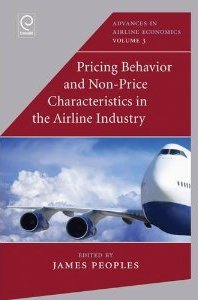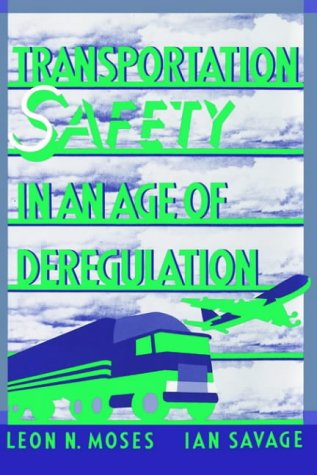
IAN SAVAGE
DEPARTMENT OF ECONOMICS
Department of Economics > Ian Savage > Aviation Safety

 1. Ian Savage (2012). Competition on the basis of safety? In James Peoples (editor) Pricing Behavior and Non-Price Characteristics in the Airline Industry. Advances in Airline Economics, Volume 3. (Bingley, UK: Emerald Book)
1. Ian Savage (2012). Competition on the basis of safety? In James Peoples (editor) Pricing Behavior and Non-Price Characteristics in the Airline Industry. Advances in Airline Economics, Volume 3. (Bingley, UK: Emerald Book)
[Publisher's Website] [Manuscript Version]
Safety is arguably the most important "quality" attribute of commercial aviation, yet it rarely figures into overt inter-firm rivalry. This chapter lays out the underlying economic models of safety provision and the demand for safety by passengers, and concludes that profit maximizing firms should seek to diversify their safety offering. However, crucial failures in market processes remove the desirability to diversify and lead to minimal product differentiation among mainstream airlines. That said, the chapter concludes by pointing to two examples of competitive markets where there are actual or imagined differences in safety between the rival airlines.
2. Ian Savage (1999). Aviation deregulation and safety in the United States: The evidence
after twenty years. In Marc Gaudry and Robert Mayes (editors) Taking Stock of Air
Liberalization (Boston: Kluwer Academic Publishers) in honor of the
25th anniversary of the Centre de Researche sur les
Transport, Universite de Montreal, and the 60th anniversary of
Transport Canada.
[1997 Conference Version]
Fatality rates for travel on jet airlines have continued their long-run decline since deregulation. However, accident rates which fell significantly in the 1960s and 1970s have remained constant since 1980 primarily because the technology of aviation safety has not changed significantly. The exception is in the commuter aviation sector where changes in safety regulation in 1978, and the substitution of turboprop for piston-engine aircraft, have produced a dramatic improvement in safety performance.
Despite the improved fatality rates there are valid concerns such as financial distress leading to skimping on safety expenditures, new entrant airlines with poor safety records, the substitution of turbo-prop aircraft for jets, poor government oversight of airlines, and increasing congestion at major airports. I estimate that deregulation has resulted in between 9 and 12 additional aviation fatalities each year. However, that number pales into insignificance compared with the 200 to 300 lives saved each year because deregulation encouraged people out of their cars and onto the airlines.
3. Lance F. Bylow and Ian Savage (1991). The effect of airline deregulation on automobile
fatalities. Accident Analysis and Prevention 23(5):443-452.
[Journal Website] [Manuscript Version]
This paper attempts to quantify the effects of airline deregulation in the United States on intercity automobile travel and consequently on the number of highway fatalities. A demand model is constructed for auto travel which includes variables representing the price and availability of air service. A reduced form model of the airline market is then estimated. Finding that deregulation has decreased airfares and increased flights, it is estimated that auto travel has been reduced by 2.2% per year on average. Given assumptions on the characteristics of drivers switching modes and the types of roads they drove on, the number of automobile fatalities averted since 1978 is estimated to be in the range 200-300 per year.
4. Leon N. Moses and Ian Savage (1989). The effect of airline pilot characteristics on
perceptions of job safety risks. Journal of Risk and Uncertainty 2(4):335-351.
[Journal Website] [Manuscript Version]
A large cross-sectional sample of commercial airline pilots in the United States were asked for their perceptions of job safety hazards. Regression techniques were employed to investigate the relationship between these perceptions and both the length of tenure of pilots, and their specific employer within the industry. The latter is found to have a far more significant impact on risk perception. No evidence was found for a "learning curve" of job risk with respect to experience. Pilots' assessment of inadequacies in training and aircraft maintenance are found to be significantly related to the financial health of their employer.
5. Leon N. Moses and Ian Savage (1990). Aviation deregulation and safety: theory and evidence.
Journal of Transport Economics and Policy 24(2):171-188.
[Published Version] [Journal Website] [JSTOR]
There is a popular belief that the economic deregulation of the United States' airline industry has led to a denigration of its safety performance. This paper describes the academic evidence on the validity of this fear. The evidence is presented within a theoretical framework which describes the potential linkages between economic conditions and the safety performance of firms.
While accident data indicate that safety has not measurably declined, there are lessons from the American experience for countries contemplating deregulation. The substantial expansion in air travel post-deregulation has not been matched by equivalent changes in federal, state and local governments' activities in overseeing safety, and providing additional infrastructure, such as airports and air traffic control. Airport and airspace congestion has been exacerbated by adherence to user fees that are not responsive to the true cost of different types of traffic (jets versus small private aircraft) and peaking in demand.
6. 1987 Conference on Transportation Deregulation and Safety in Trucking and Aviation.
On June 23, 1987 the Transportation Center of Northwestern University convened a three-day conference on the implications for safety of two pieces of legislation, the Airline Deregulation Act of 1978 and the Motor Carrier Act of 1980. These Acts had the effect of reducing the control of the federal government, and of carrier rate associations on the conditions of competition in the two industries. In particular, the regulatory reforms embodied in the two Acts allowed: greater freedom of entry into the two industries; greater freedom of entry into, and of exit from, particular markets; and greater freedom of individual rate making. The Acts significantly increased the influence of market forces on the prices charged for air and truck service, and the profitability of individual firms. Increased rate competition between motor carriers had direct effects on the rates charged by railroads for the movement of high value goods, and indirect effects on all other tariffs. The regulatory reform bills were passed because it was felt that increased competition would lead to more efficient operations and lower rates in the two industries, while not compromising safety, or seriously compromising quality of service.
View the cover, executive summary, list of contents, and introduction to the conference proceedings [11 pages, 858 kb PDF].
The results of the conference were published in a book:
The conclusions of the conference are available in the summary report on the conference which
was included in the proceedings of the conference published by Northwestern
University's Transportation Center in 1988 [26 pages, 115 kb PDF].
 Leon N. Moses and Ian Savage (editors) (1989). Transportation Safety in an Age of
Deregulation. (New York: Oxford University Press.)
Leon N. Moses and Ian Savage (editors) (1989). Transportation Safety in an Age of
Deregulation. (New York: Oxford University Press.)
[Publisher Information]
© 2013 - Last Updated: 12/12/2013 - Disclaimer